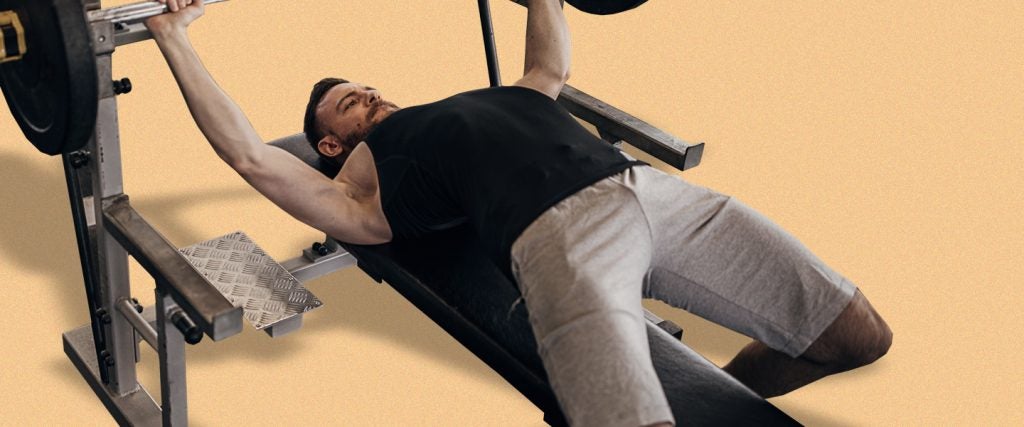Establishing the fundamentals of resistance training can be a challenge because the instant you think you’ve learned a core truth about very ordinary lifts, someone will come along and attempt to demonstrate why the “flawed” technique is actually better. Strict form curls are the best? Wrong, man. You should swing the weight up and then work the eccentric phase as it comes back down. Pull-ups are better with zero movement? Wrong again. You should flop around like a vertically oriented fish, and crank out as many reps as possible.
Then we have the bench press. You would have thought there was nothing more certain than the need for a human’s back to remain in constant contact with the bench for stable support throughout the duration of the lift. However, as you observe people bench pressing at the gym, there’s an even-money chance that at least 25 percent of them are lifting with noticeable arches in their backs.
Why do people arch their backs when they bench press?
Depending on how big the arch is, they could be doing so for any number of reasons Such as:
- Because they’re authentic powerlifters training properly.
- Because they think they’re impressing everyone around them with how much they can lift.
- Because they’ve been learning to bench press by watching powerlifters, but have no business training like them.
- Because they’re spurious powerlifters taking advantage of one of the dumbest loopholes in any competitive sport.
Let’s start at the top: Why do authentic powerlifters lift with arches in their backs?
For a couple of reasons. The lesser reason being that the arch slightly shortens the distance that the weight travels from its apex down to the chest. The foremost reason, however, is because the lower portion of the chest is where the most powerful pectoral muscle fibers are located. By benching in a competition with a back that was completely flat against a bench, the lifter would be performing the bulk of the work with the central chest fibers, with small contributions from the more powerful lower portion of the chest, as well as from the weaker upper portion of the chest that connects to the clavicle.
Basically, a mild arch shortens the distance the weight travels, while recruiting the strongest muscle fibers for the effort, and increasing the overall likelihood that the weight will be successfully returned to its starting point.
Is that how I should be lifting, too?
In a word: No. If your interest is in total muscle development, benching with a flat back during the bulk of your training is best, as it will develop the greatest overall surface area of your chest the fastest. If you’re like me and you need supplemental lifts to adequately develop the remainder of your chest, you can use an incline position on the bench to shape the upper portion, and either decline bench presses or dips for the lower segments of your chest.
What, though, did you mean about fake powerlifters and a loophole?
In a practice that’s become highly memeable, certain powerlifters are taking advantage of whatever spinal flexibility they possess and are benching with comically arched backs. The two key requirements in the official rules of competitive bench pressing that encourage these loophole lifts are as follows:
- The lifter must lie on his back with head, shoulders and buttocks in contact with the bench surface. The feet must be flat on the floor, or as flat as the shape of the shoe will allow. Their hands and fingers must grip the bar positioned in the rack stands with a thumbs around grip. This position shall be maintained throughout the lift.
- After receiving the signal, the lifter must lower the bar to the chest or abdominal area and hold it motionless on the chest, after which the chief referee will signal the audible command “press.” The lifter must then return the bar to the rack with straight arms and their elbows locked.
As you can now see, there’s no requirement that the back remain in contact with the bench throughout the lift. Second, the bar may touch either the chest or the abdominal region in order for a lift to be declared valid. Therefore, there are powerlifters who have made a mockery out of the spirit of these rules by lifting the bar over their fully arched bodies with the aid of spotters, lowering the bar a mere two inches down to their abdominal region and then pressing it two inches back to its original starting point.
This makes a mockery of powerlifting as a sport and completely defies the true reason for performing a bench press: To demonstrate total upper-body mastery over a quantity of weight and to build a thick chest.
Again, unless a certified powerlifting coach instructs you to bench press with an arch in your back — specifically because you’re training for a powerlifting competition — don’t do it as it won’t offer you any kind of benefit. Essentially, this is the rare instance where you very much want your back against the wall — or better put, against the bench.

